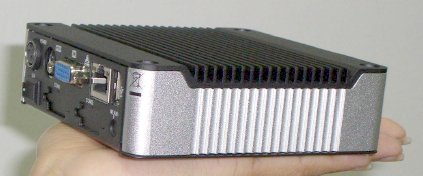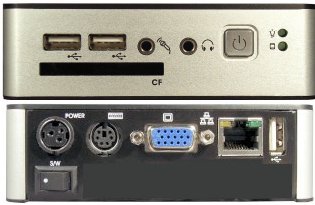Tiny, sub-$100 PC runs Puppy Linux
Aug 23, 2006 — by LinuxDevices Staff — from the LinuxDevices Archive — 61 views A Bangkok-based company is shipping a tiny, sub-$100 PC capable of running Puppy and other lightweight Linux distributions. NorhTec's MicroClient Jr. measures 4.5 inches square, draws 8 Watts, and has a 166MHz Pentium-compatible processor with three integer units. It targets thin-client, kiosk, and electronic signage applications.
A Bangkok-based company is shipping a tiny, sub-$100 PC capable of running Puppy and other lightweight Linux distributions. NorhTec's MicroClient Jr. measures 4.5 inches square, draws 8 Watts, and has a 166MHz Pentium-compatible processor with three integer units. It targets thin-client, kiosk, and electronic signage applications.

NorhTec's MicroClient Jr.
digg this story |
The MicroClient Jr. appears to the smallest of several extremely small, energy efficient PCs and servers offered by NorhTec, which in four years of operation, has supplied PCs to such big-name clients as McDonalds of Canada, according to its founder, Michael C. Barnes. Barnes says he built the company specifically to produce sub-$100 PCs, explaining, “When I founded NorhTec, I knew that in a short period, computers would drop below $100.00 USD. When that happens, it will shake up the industry because none of the major players are set up to afford their infrastructure selling computers at $100 each.”
The MicroClient Jr. saves cost in part by booting from CompactFlash, rather than a hard drive. Barnes explains, “We have been selling a product called the MicroServer General Purpose for four years now. The unit was revolutionary when it was introduced, but the price point is a bit too high because of its reliance on hard disks. Most of our customers use very little drive space, and we were spending $80.00 just to boot the system.”
Barnes adds, “We also wanted to be able to add components such as WiFi, RS232 ports, and an additional NIC.”
MicroClient Jr. features, specs
The MicroClient Jr. is based on an SIS550 from Silicon Integrated Systems (SiS). The chip integrates a complete PC chipset — including a 166MHz Pentium (MMX-capable x86) processor with three integer units (IUs), northbridge, southbridge, DRAM controller, AGP 4x VGA graphics controller, sound, software modem, and CIR controller. The complete chip dissipates a maximum of about two Watts, according to Barnes.
According to Barnes, the MicroClient Jr. is based on an embedded board supplied by an unspecified Asian OEM. The board is described as an “industrial quality” product capable of operating at temperatures up to 126 degrees F (70 degrees C). It has 128MB of soldered-on (non-upgradeable) RAM. NorhTec designs its own cases and power supplies, Barnes said.

NorhTec MicroClient Jr, front and back
 Additional touted features include:
Additional touted features include:
- Fanless Design
- VESA mounting support (as depicted at right)
- Processor — SiS 550 166Mhz x 3IUs
- Memory — soldered-on 128 MB SDRAM
- Input/output ports
- IDE
- 10/100 Mbps Ethernet
- 3 x USB V1.1
- Optional RS232
- Expansion — CompactFlash slot
- 2.5-inch hard drive mounting
- Ultra-low power
- PXE diskless boot
The OEM that supplies the MicroClient's board mainly supports Microsoft OSes on it, Barnes says, including Windows 98/ME, Windows CE, and Windows XP Embedded. However, NorhTec supports Linux, Barnes says, because “we believe [Linux] is easier to use, and better focused for people wanting a thin client.”
Barnes says the MicroClient Jr. supports most any version of Linux not based on Gnome, KDE, or other heavy desktop frameworks. He suggests using FWM95, ICEWM, XFce, or Fluxbox instead, along with free video drivers from Wini Schhofer, and sound drivers from the LTSP (Linux Terminal Server Project). Those of us who remember installing Linux on brand new Pentium I's may be tempted to put in a good word here for the highly configurable fvwm and/or fvwm2.
In particular, the MicroClient Jr. supports Puppy Linux, an ultra-lightweight Linux distribution designed to run on a ramdisk, according to Barnes.
Puppy on the MicroClient Jr.
Barnes says he successfully installed Puppy Linux on the MicroClient Jr. with help from the Puppy Linux Project's interim chairman, Raffy Mananghaya. Mananghaya describes the process as follows:
I was eager to test the device, and on August 10, having arrived in Bangkok, I contacted Michael immediately. I instructed him by phone to install Puppy Linux Barebones 2.01r2 (47 MB) to a CompactFlash device (installing it via Puppy's Universal Installer as “CF to be used later as IDE”). I chose “barebones,” as it is small enough for the 128 MB memory of the device.
NorhTec Founder Michael C. Barnes, and Puppy Linux Project Interim Chairman Raffy Mananghaya
By noon [the next day], Michael's assistant was inviting me to their office, advising that Michael was expected to be in the office, too. When I arrived there, it turned out that Michael had just bought a CF device from downtown Bangkok and installed Puppy on it following my instructions.We plugged accessories to the device: a US keyboard, a USB mouse, a CRT monitor, and the thin client's external power supply (an ordinary-looking black adapter). Michael turned the device on initially, and tried to set the screen to a high resolution (as he says he's used to high LCD resolutions) [before settling for] 1024×768. Then he tested the Internet connection via LAN, which went live quickly.
Then we started to take a video with me starting the device. Michael exclaimed “32 seconds!” when the GUI screen showed up (and I believed him, as the loading of Puppy from the CF was fast). Then I ran the network wizard immediately and was able to connect to the Internet a full minute after I pushed the [power-on] button.
(Now the sad part of the story is that Michael kept the video. Or, technically, he tried to give me a copy but my copy did not work. :) But am enclosing our pictures together with Bangkok City in the background.
The Puppy Linux site currently suggests using the MicroClient Jr. as a “woopwoop” PC, a term derived from an aboriginal word for “remote.”
Mananghaya concludes, “Considering that most of the time, these devices will not be crunching numbers, but [will] simply move data in/out of servers/Internet and display/output them, the SiS configuration of low processor speed but high display and data pipelining is attractive. And with Puppy residing in memory (thus removing data fetching from storage), there is less demand on the processor.”
Availability
The MicroClient Jr. is available now, priced at $120, or $90 in quantities of a thousand or more. Barnes adds, “We hope that we can even get below that if we can get to much larger quantities.”
For further details, visit the company's website.
This article was originally published on LinuxDevices.com and has been donated to the open source community by QuinStreet Inc. Please visit LinuxToday.com for up-to-date news and articles about Linux and open source.
